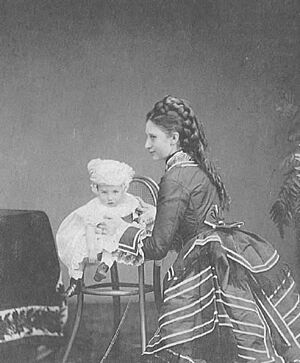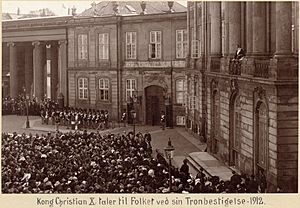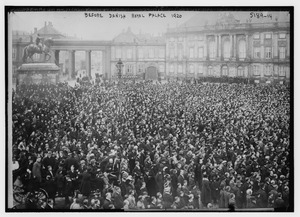Christian X of Denmark facts for kids
Quick facts for kids Christian X |
|||||
|---|---|---|---|---|---|

Christian X by Peter Elfelt
|
|||||
| King of Denmark (more...) | |||||
| Reign | 14 May 1912 – 20 April 1947 | ||||
| Predecessor | Frederick VIII | ||||
| Successor | Frederick IX | ||||
| Prime Ministers |
See list
Carl Theodor Zahle
Otto Liebe Michael Pedersen Friis Niels Neergaard Thorvald Stauning Thomas Madsen-Mygdal Vilhelm Buhl Erik Scavenius Knud Kristensen |
||||
| King of Iceland | |||||
| Reign | 1 December 1918 – 17 June 1944 | ||||
| Prime Ministers |
See list
Jón Magnússon
Sigurður Eggerz Magnús Guðmundsson Jón Þorláksson Tryggvi Þórhallsson Ásgeir Ásgeirsson Hermann Jónasson Ólafur Thors Björn Þórðarson |
||||
| Born | 26 September 1870 Charlottenlund Palace, Copenhagen, Denmark |
||||
| Died | 20 April 1947 (aged 76) Amalienborg Palace, Copenhagen, Denmark |
||||
| Burial | Roskilde Cathedral, Roskilde, Denmark | ||||
| Spouse |
Alexandrine of Mecklenburg-Schwerin
(m. 1898) |
||||
| Issue |
|
||||
|
|||||
| House | Glücksburg | ||||
| Father | Frederick VIII of Denmark | ||||
| Mother | Louise of Sweden | ||||
| Religion | Lutheranism | ||||
| Signature | |||||
Christian X (born September 26, 1870 – died April 20, 1947) was the King of Denmark from 1912 until his death in 1947. He was also the only King of Iceland (known there as Kristján X) from 1918 to 1944. This was a "personal union," meaning he was king of both countries, but they were separate nations.
Christian X was part of the House of Glücksburg, a royal family. He was the first Danish monarch in a long time to be born into the Danish royal family itself. His younger brother became King Haakon VII of Norway. Christian's son, Frederick IX of Denmark, later became King of Denmark.
Christian X was known for being a strong leader. He believed that the king should have a lot of power. This led to a big event in 1920 called the Easter Crisis of 1920. During this crisis, he fired the government that the people had elected because he disagreed with them. This was allowed by the old rules, but Denmark had been moving towards a system where the elected parliament had more power than the king. People protested, and there was even a risk that the monarchy could be ended. Christian X then had to accept that a king could not rule against the will of the parliament. After this, he became more of a symbolic head of state.
During World War II, Christian X became a symbol of hope and resistance for the Danish people. He was famous for riding his horse every day through the streets of Copenhagen without any guards. His reign covered two world wars, and his role during the German occupation made him one of the most loved Danish kings in modern times.
Contents
Early Life and Family
Christian was born on September 26, 1870, at Charlottenlund Palace, a country home near Copenhagen, Denmark. His grandfather, King Christian IX, was the reigning king at the time. Christian was the first child of Crown Prince Frederick and his wife Louise of Sweden. His father was the oldest son of King Christian IX, and his mother was the only daughter of King Charles XV of Sweden and Norway.
The famous author Hans Christian Andersen wrote in his diary the day after Christian was born: "The night before 12 a Prince was born by the Crown Princess, the whole city flagged today in the beautiful weather." Christian was baptized on October 31, 1870, at Christiansborg Palace Chapel.
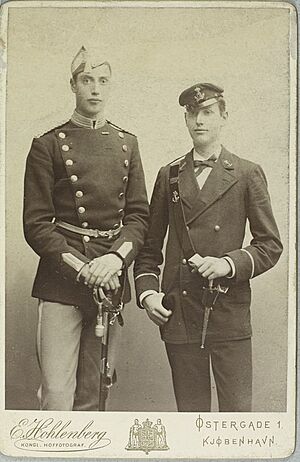
Prince Christian and his siblings grew up in Copenhagen. They spent time at their parents' home, Frederick VIII's Palace (part of Amalienborg Palace), and their country home, Charlottenlund Palace. Since he was the oldest son of the Crown Prince, Christian was second in line to the throne after his father.
Unlike many royal children of that time, Christian and his siblings were raised by their mother, Crown Princess Louise. She gave them a strict upbringing, focusing on duty and order. Christian was less than two years older than his brother Prince Carl. They had their joint confirmation (a religious ceremony) in 1887. In 1889, Christian became the first Danish royal to pass the examen artium, which was the university entrance exam. After that, he joined the military, which was common for princes.
Marriage and Children
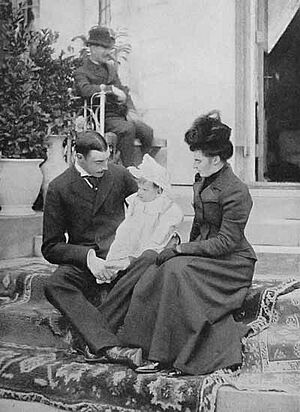
When he was young, Prince Christian was interested in Princess Marguerite of Orléans from France. However, she did not feel the same way and later married someone else.
Christian married Alexandrine of Mecklenburg-Schwerin in Cannes, France, on April 26, 1898. She was the daughter of a German Grand Duke. She later became his Queen. They had two sons:
- Prince Frederick (1899–1972), who later became King Frederick IX of Denmark.
- Prince Knud (1900–1976), who became Knud, Hereditary Prince of Denmark.
The couple lived in Christian VIII's Palace at Amalienborg Palace in Copenhagen. They also had a summer home called Sorgenfri Palace. In 1898, the people of Denmark gave them Marselisborg Palace in Aarhus as a wedding gift.
Becoming Crown Prince
On January 29, 1906, King Christian IX died. Christian's father then became King Frederick VIII, and Christian himself became the Crown Prince.
Becoming King
On May 14, 1912, King Frederick VIII died suddenly in Hamburg, Germany. Christian was in Copenhagen when he heard the news. He then became King Christian X.
The Easter Crisis of 1920
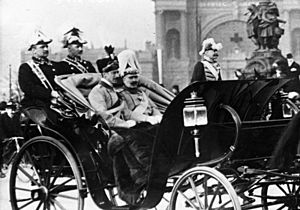
In April 1920, King Christian X caused a major political event known as the Easter Crisis. This was a very important moment for how the Danish monarchy would work in the future. The problem started because of a disagreement between the King and the government about Schleswig. This area used to be part of Denmark but was lost to Germany. After World War I, parts of Schleswig were allowed to vote on whether they wanted to rejoin Denmark.
People in Northern Schleswig voted to rejoin Denmark, and that area became part of Denmark again. In Central Schleswig, most people voted to stay with Germany. The Prime Minister, Carl Theodor Zahle, decided that only Northern Schleswig should rejoin Denmark. However, many Danish nationalists, including King Christian X, felt that the city of Flensburg in Central Schleswig should also return to Denmark.
King Christian X ordered Prime Minister Zahle to include Flensburg in the reunification. But Denmark had been a parliamentary democracy since 1901, meaning the elected parliament and its government had the main power. Zahle felt he didn't have to obey the King's order. He refused and resigned after a heated argument with the King.
King Christian X then fired the rest of the government and put in a new one that he chose. This caused huge protests and a very tense situation in Denmark. For a few days, it seemed like the monarchy might even be overthrown. Because of this, the King had to negotiate with the Social Democrats, a major political party.
Faced with the risk of losing his throne, Christian X backed down. He dismissed his own government and allowed a new, temporary government to be formed until new elections could be held. This was the last time a Danish king tried to take political action without the full support of the parliament. After this crisis, Christian X accepted his new, more limited role as a symbolic leader.
World War II and German Occupation
On April 9, 1940, at 4 AM, Nazi Germany suddenly invaded Denmark. Denmark's army and navy were quickly overwhelmed. King Christian X realized that Denmark could not fight against Germany for long. Denmark is a flat country, which meant German tanks could easily take over. Also, unlike its neighbors, Denmark had no mountains for a long resistance fight.
With no way to hold out, and facing threats of bombing Copenhagen, King Christian X and the Danish government surrendered around 6 AM. In return, Denmark was allowed to keep some control over its own affairs. This began the occupation of Denmark, which lasted until May 5, 1945.
Unlike many other European leaders who went into exile, King Christian X stayed in Copenhagen during the German occupation. He became a visible symbol of hope and national pride for the Danish people.
Until August 1943, Christian's speeches followed the government's policy of working with the Germans. However, Danes still saw him as a symbol of "mental resistance." For the first two years of the occupation, despite his age, he rode his horse, Jubilee, through Copenhagen every day without any guards. A popular way for Danes to show their patriotism and quiet resistance was to wear a small pin with the Danish flag and the King's symbol, called the Kongemærket (King's Emblem pin). The King also helped pay for the transport of Danish Jews to neutral Sweden, where they would be safe from the Nazis.
In 1942, Adolf Hitler sent Christian a long telegram for his 72nd birthday. The King's reply was very short: Spreche Meinen besten Dank aus. Chr. Rex (Giving my best thanks, King Christian). This short reply, known as the Telegram Crisis, made Hitler very angry. He recalled his ambassador from Copenhagen and sent the Danish ambassador away from Germany. This led to changes in the Danish government, with the Germans expecting a more cooperative leader.
After a fall from his horse in October 1942, Christian was not as active for the rest of his reign. While the Easter Crisis had made him less popular, his daily rides, the Telegram Crisis, and stories spread by Danish-Americans made him a beloved national symbol once again.
King of Iceland
In 1918, a new agreement made Iceland, which had long been part of Denmark, a separate country in a "personal union" with Denmark. This meant Christian was also the King of Iceland (where he was called Kristján X). He was the only king to rule Iceland as a sovereign kingdom.
In 1941, after Germany occupied Denmark and the Allies occupied Iceland, the Icelandic government decided that Christian could not perform his duties as their head of state. So, they appointed Sveinn Björnsson as a temporary leader.
In 1944, while Denmark was still occupied, Icelanders voted to break all ties with the King of Denmark and become a republic. So, Christian was no longer King of Iceland. Sveinn Björnsson became the first President of Iceland. Christian felt a bit betrayed because he thought Iceland wouldn't become fully independent during the war. However, his relative, the King of Sweden, encouraged him to accept it. Christian sent a message of congratulations to Iceland when they became a republic on June 17, 1944. Even though he accepted it, Christian continued to use the title "King of Iceland" until he died in 1947.
Death and Burial
King Christian X died at Amalienborg Palace in Copenhagen in 1947. He was buried with other Danish royals in Roskilde Cathedral near Copenhagen. Even though he had supported some policies that cooperated with the Germans, a special armband worn by members of the Danish resistance movement was placed on his coffin. This showed that he was seen as a symbol of resistance.
Popular Stories and Legends
Many stories and legends grew around King Christian X, especially during World War II, showing his popularity and the Danish spirit of resistance.
One famous story says that a German soldier once asked a young boy why the King rode without bodyguards. The boy supposedly replied, "All of Denmark is his bodyguard." This story is told in books like Bright Candles and Number the Stars. A patriotic Danish song, "Der rider en Konge" (There Rides a King), also talks about the King's rides, saying he is guarded by the "hearts of Denmark."
Another popular, but untrue, story was about the German flag flying over the Hotel d'Angleterre, which was used as German headquarters. The story says the King saw the flag and told a German guard it had to come down. When the guard refused, the King said he would send a Danish soldier to take it down. The guard threatened to shoot the soldier, and the King replied, "The Danish soldier will be me." According to the legend, the flag was then taken down.
King Christian X also became part of myths about his support for Danish Jews. A persistent urban legend says that during the Nazi occupation, when Nazis forced Jews to wear the Star of David, the King himself put on a Star of David to show solidarity. However, in Denmark, Jews were never forced to wear the Star of David. This legend likely started from a 1942 British report that claimed he threatened to wear the star if it was forced upon Danish Jews. It became very popular after being included in the novel Exodus.
It is true, however, that the King intended to wear the star if Danish Jews were forced to. In his personal diary, he wrote that if such a demand were made, "we would best meet it by all wearing the Star of David."
Titles and Honours
Christian X held several titles throughout his life:
- From 1870 to 1906: Prince Christian of Denmark
- From 1906 to 1912: The Crown Prince of Denmark
- From 1912 to 1918: The King of Denmark
- From 1918 to 1944: The King of Denmark and Iceland
- From 1944 to 1947: The King of Denmark
King Christian X Land in Greenland is named after him. He also received many honours from Denmark and other countries, such as the Order of the Elephant (Denmark's highest honour) and the Order of the Garter from the United Kingdom.
Children
| Name | Birth | Death | Spouse | Children |
|---|---|---|---|---|
| Frederick IX of Denmark | 11 March 1899 | 14 January 1972 | Princess Ingrid of Sweden | Margrethe II of Denmark Benedikte, Dowager Princess of Sayn-Wittgenstein-Berleburg Anne-Marie, Queen of the Hellenes |
| Knud, Hereditary Prince of Denmark | 27 July 1900 | 14 June 1976 | Princess Caroline-Mathilde of Denmark | Princess Elisabeth of Denmark Count Ingolf of Rosenborg Count Christian of Rosenborg |
Images for kids
See also
 In Spanish: Cristián X de Dinamarca para niños
In Spanish: Cristián X de Dinamarca para niños


